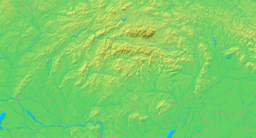- Stará Ľubovňa
-
Stará Ľubovňa Town Stará Ľubovňa Castle and an open air folk museumCountry Slovakia Region Prešov District Stará Ľubovňa Tourism region Spiš River Poprad Elevation 545 m (1,788 ft) Coordinates 49°18′34″N 20°40′44″E / 49.30944°N 20.67889°E Area 30.79 km2 (11.89 sq mi) Population 16,363 (31 December 2005) Density 531 / km2 (1,375 / sq mi) First mentioned 1292 Mayor Valent Jaržembovský Timezone CET (UTC+1) - summer (DST) CEST (UTC+2) Postal code 064 01 Area code +421-52 Car plate SL Wikimedia Commons: Stará Ľubovňa Statistics: MOŠ/MIS Website: www.staralubovna.sk Stará Ľubovňa (German: Altlublau; Hungarian: Ólubló; Latin: Lublovia; Polish: Lubowla) is a town with approximately 16,000 inhabitants in northeastern Slovakia. The town consists of the districts Podsadek and Stará Ľubovňa.
Contents
Geography
Stará Ľubovňa is situated on the Poprad River 15 km south of the Polish border and 30 km east of the High Tatras. It is one of the oldest towns in the Spiš, an historic administrative county (comitatus) of the Kingdom of Hungary, and is today the administrative capital of the district of Stará Ľubovňa in the Prešov Region.
History
In 1292 Stará Ľubovňa is first mentioned as Libenow. Until it became a free royal town in 1364 the town fell under the jurisdiction of the castle.
In 1412 it belonged to the 16 Spiš towns given by the Hungarian King Sigismund of Luxemburg as a deposit to King Władysław II of Poland. The pledge was part of the Treaty of Lubowla and was thought to be only for a short time, but it finally lasted for 360 years. Only in the course of the first Partition of Poland in 1772 during the reign of Maria Theresa of Austria the territory came back to the Kingdom of Hungary. The pledge was actually an advantage for the towns concerned because they did not have to submit themselves to the comitatus or nobility and had a neutral position in turmoils between Poland and Hungary.
Sights
From a hill over the city the castle of Ľubovňa dominates the city. The castle is open to the public and houses a museum about its history. From its already reconstructed tower there are good views over the surroundings. Next to the castle there is an open-air museum, Ľubovňansky skanzen, with many houses and other buildings showing the folk architecture of the region. The most interesting exhibit is the wooden Greek-Catholic church from Matysová, built in 1833.
The old town consists mainly of the rectangular St. Nicolas Square which is surrounded by burgher’s houses of the 17th century. In the centre there is the gothic Roman Catholic Church of St. Nicolas built in 1280.
Another building of interest is the new Greek-Catholic church of the Mother of Eternal Help in the south of the city. It was consecrated by Pope John Paul II on 22 April 1990 and is constructed in the shape of a royal crown.
Demographics
According to the 2001 census, the town had 16,227 inhabitants. 89.5% of inhabitants were Slovaks, 5.97% Roma, 1.48% Rusyn, 1.00% Ukrainian and 0.64% Czechs.[1] The religious make-up was 67.65% Roman Catholics, 22.20% Greek Catholics, 5.01% people with no religious affiliation, 1.61% Orthodox and 0.81% Lutherans.[1]
Famous residents
- Marcel Hossa, professional ice hockey forward
- Marián Hossa, professional ice hockey right winger
- Marcin Oracewicz (pl)
- Zita Pleštinská, politician and Member of the European Parliament
International relations
See also: List of twin towns and sister cities in SlovakiaTwin towns — Sister cities
Stará Ľubovňa is twinned with:
Gallery
References
Bibliography
- Okresný národný výbor: Okres Stara Ľubovňa
- Turistický sprievodca: Slovenské kráľovské mestá Bardejov, Kežmarok, Levoča, Stará Ľubovňa
Notes
- ^ a b "Municipal Statistics". Statistical Office of the Slovak republic. Archived from the original on 2007-12-17. http://web.archive.org/web/20071217080336/http://www.statistics.sk/mosmis/eng/run.html. Retrieved 2007-12-28.
- ^ "Nowy Sącz - Partner Cities". © 2008 Urząd Miasta Nowego Sącza, Rynek 1, 33-300 Nowy Sącz. http://www.nowysacz.pl/?p=1&p2=167&main=inc-miastapar. Retrieved 2008-12-07.
External links
Podolínec · Stará Ľubovňa
Čirč · Ďurková · Forbasy · Hajtovka · Haligovce · Hniezdne · Hraničné · Hromoš · Chmeľnica · Jakubany · Jarabina · Kamienka · Kolačkov · Kremná · Kyjov · Lacková · Legnava · Lesnica · Litmanová · Lomnička · Ľubotín · Malý Lipník · Matysová · Mníšek nad Popradom · Nižné Ružbachy · Nová Ľubovňa · Obručné · Orlov · Plaveč · Plavnica · Pusté Pole · Ruská Voľa nad Popradom · Starina · Stráňany · Sulín · Šambron · Šarišské Jastrabie · Údol · Veľká Lesná · Veľký Lipník · Vislanka · Vyšné Ružbachy Categories:
Categories:- Cities and towns in Slovakia
- Spiš
Wikimedia Foundation. 2010.












